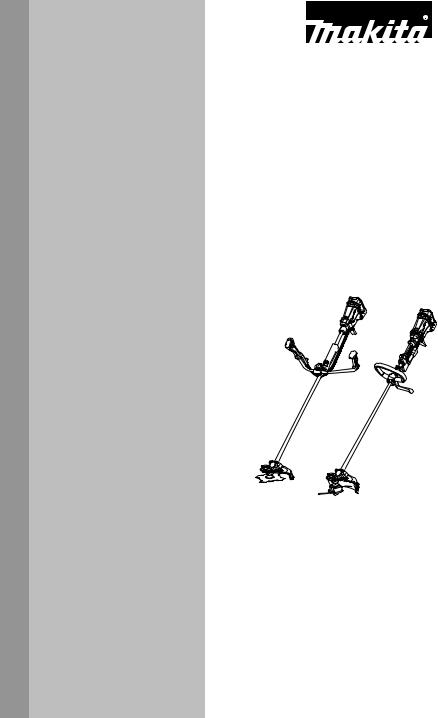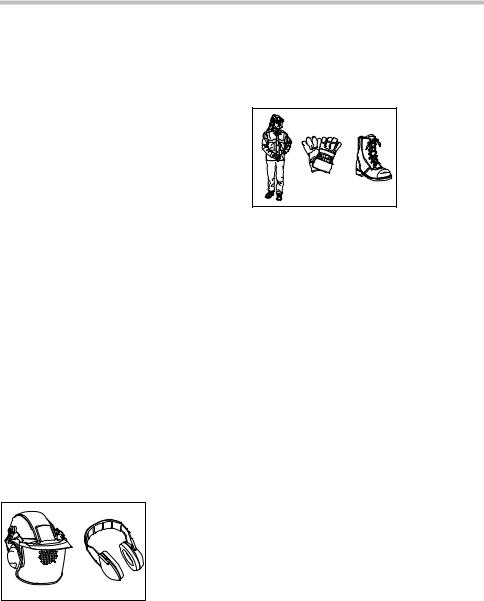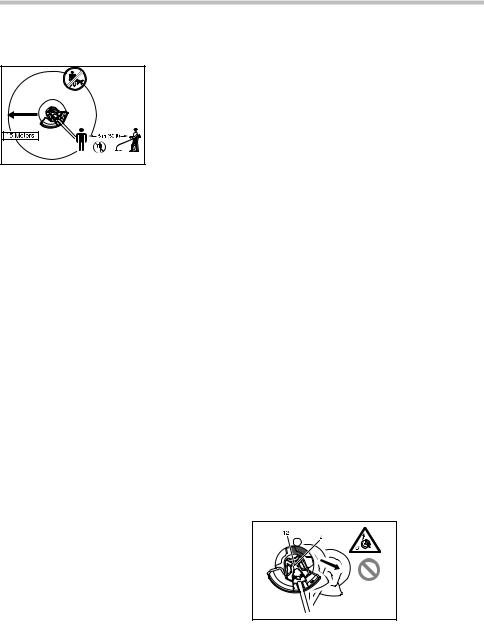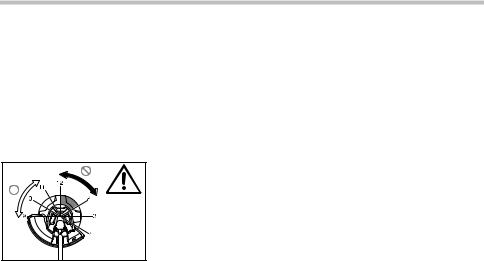Makita BBC300LRD, BBC231U, BBC300L Manual

instructions) (Original ENGLISH
INSTRUCTION MANUAL
Cordless Brushcutter /
Cordless String Trimmer
BBC231U
BBC300L
010751
IMPORTANT: Read Before Using.

ENGLISH (Original instructions)
SPECIFICATIONS
Model |
|
BBC231U |
|
BBC300L |
|
Type of handle |
|
Bike handle |
|
Loop handle |
|
No load speed |
|
High |
0 - 7,300 min-1 |
|
0 - 6,600 min-1 |
|
Low |
0 - 5,300 min-1 |
|
0 - 4,900 min-1 |
|
|
|
|
|||
Overall length |
|
1,880 mm |
|
1,850 mm |
|
Cutting blade diameter |
|
230 mm |
|
- |
|
Cutting diameter with nylon cutting head |
- |
|
300 mm |
||
Net weight |
|
7.1 kg |
|
5.9 kg |
|
Rated voltage |
|
|
D.C. 36 V |
||
Standard battery cartridge(s) |
|
|
BL3626 |
||
Warning: Use only the battery cartridge(s) described. |
|
||||
|
|
|
|||
|
|
|
|
|
|
•Due to our continuing program of research and development, the specifications herein are subject to change without notice.
•Specifications and battery cartridge may differ from country to country.
•Weight, with battery cartridge, according to EPTA-Procedure 01/2003
END008-1
Symbols
The following show the symbols used for the equipment. Be sure that you understand their meaning before use.  Take particular care and attention.
Take particular care and attention.
Read instruction manual.
Danger; be aware of thrown objects.
electronic equipment, 2006/66/EC on batteries and accumulators and waste batteries and accumulators and their implementation in accordance with national laws, electric equipment and battery pack that have reached the end of their life must be collected separately and returned to an environmentally compatible recycling facility.
GEB068-2
Cd
Ni-MH
Li-ion
The distance between the tool and bystanders must be at least 15 m.
Keep bystanders away.
Keep distance at least 15 m.
Avoid kickback.
Wear a helmet, goggles and ear protection.
Wear protective gloves.
Wear sturdy boots with nonslip soles. Steeltoed safety boots are recommended.
Do not expose to moisture.
Top permissible tool speed.
Only for EU countries
Do not dispose of electric equipment or battery pack together with household waste material!
In observance of European Directive 2002/96/EC on waste electric and
IMPORTANT SAFETY INSTRUCTIONS
 WARNING! Read all safety warnings and all instructions. Failure to follow the warnings and instructions may result in electric shock, fire and/or serious injury.
WARNING! Read all safety warnings and all instructions. Failure to follow the warnings and instructions may result in electric shock, fire and/or serious injury.
Save all warnings and instructions for future reference.
General instructions
1.Do not allow persons unfamiliar with the brushcutter/string trimmer or these instructions to operate the tool. Brushcutter and String trimmers are dangerous in the hands of untrained users.
2.Be sure that anyone who is to operate the brushcutter/string trimmer has first read the instruction manual.
3.Never allow people unfamiliar with these instructions, people (including children) with reduced physical, sensory or mental capabilities, or lack of experience and knowledge to use the tool. Local regulations can restrict the age of the operator.
2

4.Use the tool with the utmost care and attention.
5.Operate the tool only if you are in good physical condition. Perform all work calmly and carefully. Use common sense and keep in mind that the operator or user is responsible for accidents or hazards occurring to other people or their property.
6.Never operate the tool when tired, feeling ill or under the influence of alcohol or drugs.
7.The tool should be switched off immediately if it shows any signs of abnormal operation.
8.Disconnect the battery from the tool before making any adjustments, changing accessories or storing. Such preventive safety measures reduce the risk of starting the tool accidentally.
9.Don't force the tool. it will do the job better and with less likelihood of a risk of injury at the rate for which it was designed.
10.Don't overreach. Keep proper footing and balance at all times.
Intended use of the tool
1.Use right tool. The cordless brushcutter/string trimmer is only intended for cutting grass, weeds, bushes and undergrowth. It should not be used for any other purpose such as edging or hedge cutting as this may cause injury.
Personal protective equipment
1.Dress Properly. The clothing worn should be functional and appropriate, i.e. it should be tight-fitting but not cause hindrance. Do not wear either jewelry or clothing which could become entangled with bushes or shrubs. Wear protective hair covering to contain long hair.
2.In order to avoid either head, eye, hand or foot injuries as well as to protect your hearing the following protective equipment and protective clothing must be used during operation of the equipment.
010820
3.Always wear a helmet where there is a risk of falling objects. The protective helmet is to be checked at regular intervals for damage and is to be replaced at least every five years. Use only approved protective helmets.
4.The visor of the helmet (or alternatively goggles) protects the face from flying debris and stones.
During operation of the tool always wear goggles, or a visor to prevent eye injuries.
5.Wear adequate noise protection equipment to avoid hearing impairment (ear muffs , ear plugs etc.).
010821
6.Work overalls protect against flying stones and debris. It is strongly recommended that the user wears work overalls.
7.Special gloves made of thick leather are part of the prescribed equipment and must always be worn during operation of the tool.
8.When using the tool, always wear sturdy shoes with a nonslip sole. This protects against injuries and ensures a good footing.
Electrical and battery safety
1.Avoid dangerous environment. Don't use the tool in damp or wet locations or expose it to rain. Water entering the tool will increase the risk of electric shock.
2.Recharge only with the charger specified by the manufacturer. A charger that is suitable for one type of battery pack may create a risk of fire when used with another battery pack.
3.Use power tools only with specifically designated battery packs. Use of any other battery packs may create a risk of injury and fire.
4.When battery pack is not in use, keep it away from other metal objects, like paper clips, coins, keys, nails, screws or other small metal objects, that can make a connection from one terminal to another. Shorting the battery terminals together may cause burns or a fire.
5.Under abusive conditions, liquid may be ejected from the battery; avoid contact. If contact accidentally occurs, flush with water. If liquid contacts eyes, seek medical help. Liquid ejected from the battery may cause irritation or burns.
6.Do not dispose of the battery(ies) in a fire. The cell may explode. Check with local codes for possible special disposal instructions.
7.Do not open or mutilate the battery(ies). Released electrolyte is corrosive and may cause damage to the eyes or skin. It may be toxic if swallowed.
3

Starting up the tool
360° |
010822 |
1.Make sure that there are no children or other people within a working range of 15 meters (50 ft), also pay attention to any animals in the working vicinity. Otherwise stop using the tool.
2.Before use always check that the tool is safe for operation. Check the security of the cutting tool and the guard and the switch trigger/lever for easy and proper action. Check for clean and dry handles and test the on/off function of the switch.
3.Check damaged parts before further use of the tool. A guard or other part that is damaged should be carefully checked to determine that it will operate properly and perform its intended function. Check for alignment of moving parts, binding of moving parts, breakage of parts, mounting, and any other condition that may affect its operation. A guard or other part that is damaged should be properly repaired or replaced by our authorized service center unless indicated elsewhere in this manual.
4.Switch on the motor only when hands and feet are away from the cutting tool.
5.Before starting make sure that the cutting tool has no contact with hard objects such as branches, stones etc. as the cutting tool will revolve when starting.
Method of operation
1.Only use the tool in good light and visibility. During the winter season beware of slippery or wet areas, ice and snow (risk of slipping). Always ensure a safe footing.
2.Take care against injury to feet and hands from the cutting tool.
3.Never cut above waist height.
4.Never stand on a ladder and run the tool.
5.Never climb up into trees to perform cutting operation with the tool.
6.Never work on unstable surfaces.
7.Remove sand, stones, nails etc. found within the working range. Foreign particles may damage the cutting tool and can cause dangerous kick-backs.
8.Should the cutting tool hit stones or other hard objects, immediately switch off the motor and
inspect the cutting tool.
9.Inspect the cutting blade at short regular intervals for damage (detection of hairline cracks by means of tapping-noise test).
10.Before commencing cutting, the cutting tool must have reached full working speed.
11.Operate the tool only with the shoulder harness attached which is to be suitably adjusted before putting the tool into operation. It is essential to adjust the shoulder harness according to the user size to prevent fatigue occurring during use.
12.During operation always hold the tool with both hands. Never hold the tool with one hand during use. Always ensure a safe footing.
13.The cutting tool has to be equipped with the guard. Never run the tool with damaged guards or without guards in place!
14.All protective equipment such as guards and the shoulder harness supplied with the tool must be used during operation.
15.Never hit weeds or similar materials with the cutting tool to cut them away.
16.Except in case of emergency, never drop or cast the tool to the ground or this may severely damage the tool.
17.Never drag the tool on the ground when moving from place to place, the tool may become damaged if moved in this manner.
18.Always remove the battery cartridge from the tool:
−whenever leaving the tool unattended;
−before clearing a blockage;
−before checking, cleaning or working on the tool;
−whenever the tool starts vibrating abnormally.
19.Always ensure that the ventilation openings are kept clear of debris.
Kickback (blade thrust)
1.When operating the tool, uncontrolled kickback (blade thrust) may occur.
010810 |
2.This is particularly the case when attempting to cut within a blade segment between 12 and 2 o'clock.
3.Never apply the tool within a segment between 12 and 2 o'clock.
4

4.Never apply this segment of the cutter blade to solids, such as bushes and trees, etc., having a diameter in excess of 3 cm or the cutter blade will be deflected at great force with the risk of injuries.
Kickback prevention
To avoid kickbacks, observe the following:
1.Operation within a blade segment between 12 and 2 o'clock presents positive hazards, especially when using metal cutting tools.
010811 |
2.Cutting operations within a blade segment between 11 and 12 o'clock, and between 2 and 5 o'clock, must only be performed by trained and experienced operators, and then only at their own risk.
3.Easy cutting with almost no kickback is possible within a blade segment between 9 and 11 o'clock.
Cutting Tools
1.Employ only the correct cutting tool for the job in hand.
2.To cut thick materials, such as weed, high grass, bushes, shrubs, underwood, thicket etc. (max. 2 cm dia. thickness), perform the cutting work by swinging the tool evenly in half-circles from right to left (similar to using a scythe).
Maintenance instructions
1.The condition of the cutting tool, protective devices and shoulder harness must be checked before commencing work.
2.Particular attention is to be paid to the cutting blades which must be correctly sharpened.
3.Turn off the motor and remove the battery cartridge before carrying out maintenance, replacing the cutting tool and cleaning the tool.
4.Check for loose fasteners and damaged parts such as cracks in the cutting tool.
5.Follow instructions for lubricating the tool.
6.When not in use store the equipment in a dry location that is locked up or out of children's reach.
7.Use only the manufacturer's recommended replacement parts and accessories.
8.Inspect and maintain the tool regularly, especially before/after use. Have the tool repaired only by our authorized service center.
9.Keep handles dry, clean and free from oil and grease.
SAVE THESE INSTRUCTIONS.
 WARNING:
WARNING:
DO NOT let comfort or familiarity with product (gained from repeated use) replace strict adherence to safety rules for the subject product. MISUSE or failure to follow the safety rules stated in this instruction manual may cause serious personal injury.
ENC007-5
IMPORTANT SAFETY INSTRUCTIONS
FOR BATTERY CARTRIDGE
1.Before using battery cartridge, read all instructions and cautionary markings on (1) battery charger, (2) battery, and (3) product using battery.
2.Do not disassemble battery cartridge.
3.If operating time has become excessively shorter, stop operating immediately. It may result in a risk of overheating, possible burns and even an explosion.
4.If electrolyte gets into your eyes, rinse them out with clear water and seek medical attention right away. It may result in loss of your eyesight.
5.Do not short the battery cartridge:
(1)Do not touch the terminals with any conductive material.
(2)Avoid storing battery cartridge in a container with other metal objects such as nails, coins, etc.
(3)Do not expose battery cartridge to water or rain.
A battery short can cause a large current flow, overheating, possible burns and even a breakdown.
6.Do not store the tool and battery cartridge in
locations where the temperature may reach or exceed 50 C (122 F).
7.Do not incinerate the battery cartridge even if it is severely damaged or is completely worn out. The battery cartridge can explode in a fire.
8.Be careful not to drop or strike battery.
9.Do not use a damaged battery.
SAVE THESE INSTRUCTIONS.
5

Tips for maintaining maximum battery life
1.Charge the battery cartridge before completely discharged.
Always stop tool operation and charge the battery cartridge when you notice less tool power.
2.Never recharge a fully charged battery cartridge.
Overcharging shortens the battery service life.
3.Charge the battery cartridge with room temperature at 10 C - 40 C (50 F - 104 F).
Let a hot battery cartridge cool down before charging it.
6
